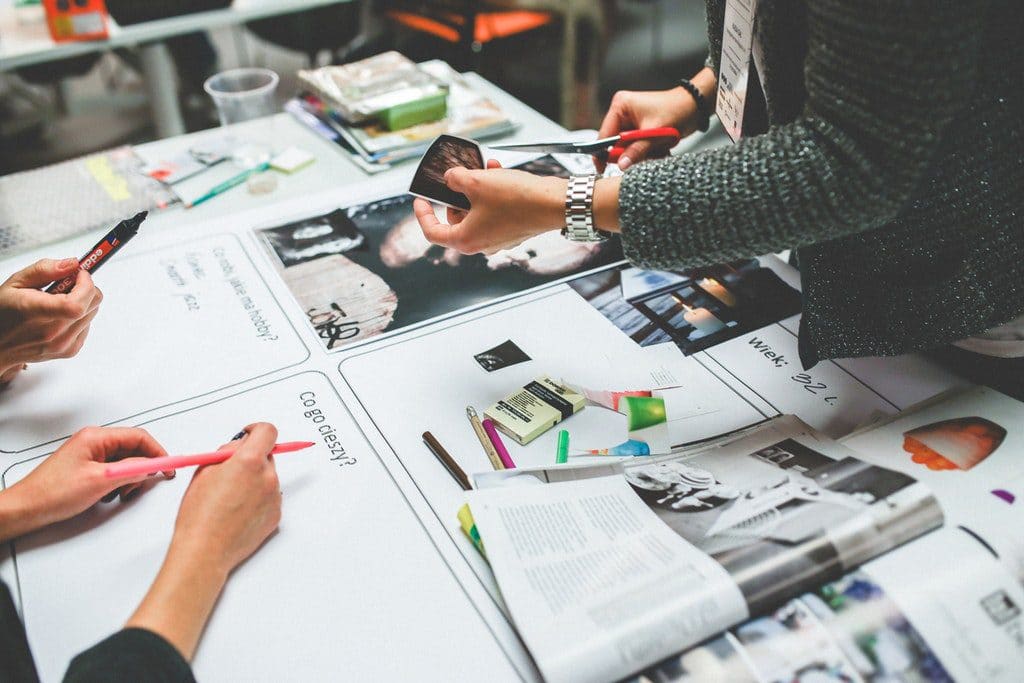This article was contributed by Melissa Pallotti of Dropbox.
Give Every Step of Your Process – from Brainstorming to Creating the Final Product – a Boost
According to movies and television shows, the design process is really pretty simple: you’re walking your dog/ hanging out at an all-night diner/ sitting at your desk, and you’re suddenly struck with a brilliant idea. You sketch it up, present it to someone, and boom – you have successfully designed a product that is ready to be sent out into the world. Whether you’re an artist, an engineer, a product designer, or anyone else who engages with the creative process, you know that it’s rarely that straightforward. The creative process is called a process for a reason!
Lately “design thinking” has been creating a lot of buzz in the design community because it promises to make the creative process simpler and more effective. But what is design thinking, and what can you really learn from it?
In this article, we’ll take you through everything you need to know to transform your creative process with design thinking, including:
- What design thinking is
- A little bit of history on design thinking
- An overview of the building blocks of design thinking
- Strategies and tools for incorporating design-thinking into your creative process

Design thinking is a way of approaching the creative process to generate more (and better!) ideas and more effective designs.
What is design thinking?
If you do an internet search for a definition of design thinking, thousands of articles, news stories, and videos will come up – many of them from prominent publications like Forbes and The Harvard Business Review. Design thinking has been written about and defined in many ways by many people – but at its heart, what is it?
Most sources agree that design thinking is a slight variation on a traditional design process. What sets it apart from the design work of your parents and grandparents – or even the design techniques you learned in school – can be broken down into three major categories:
- Focus
- Speed
- Process
Focus on Human-Centeredness
Human-centered design is exactly what it sounds like – design that takes extra care to anticipate and meet the needs of its audience. Of course, on a basic level, this is what all designs seek to do. However, design thinking disrupts old ideas about what it means to create a human-centered product by recognizing a few things:
- Designers should look at the project from the perspective of the end user
- The people who know the project best may have developed biases about it
- The key to creating effective designs is empathy
Emphasis on Rapid Iteration
It’s not likely that you’ll create the perfect design on the first try, which is why revision is such an important part of any design process. In design thinking, iterating through many different versions of an idea is essential to figuring out what is working well in a design and what is not. To do this, design thinkers use strategies like:
- Relying on quick prototypes/drafts to communicate ideas
- Creating prototypes/drafts that can easily be adjusted
- Producing a high-resolution prototype only after several rounds of low-resolution prototyping
Increasingly Collaborative Process
Avoiding your own personal biases and opinions is absolutely essential if you want to create a product that truly meets the needs of your audience. But how can you tell whether your idea will be a good solution? Design thinkers check their own personal biases through collaboration in several ways:
- Seeking out and incorporating feedback from stakeholders
- Seeking out and incorporating advice from experts when necessary
- Brainstorming with a team of designers to come up with an appropriate solution

Working with others to brainstorm and design solutions helps you create better, more effective designs.
Where did design thinking come from?
Although design thinking has started making headlines only recently, the roots of design thinking can actually be traced back more than 50 years. In this section, we’ll give a brief overview of the people and movements that have influenced design thinking since the 1960s.
A Creative Revolution: 1960-1980
The 1960s and 1970s were revolutionary in many ways – people were creating music, art, and change in ways the world had never seen before. These two decades had a profound impact on design as well.
The emergence of design science and ergonomics, as well as design strategies such as cooperative design, set the stage for what would later become design thinking and human-centered design.
Understanding Creators: 1980-1990
With the foundation of design thinking already laid, the world became increasingly interested in something else – what exactly makes a creative person creative, and what sets that person apart from everybody else?
During this era, psychologists and sociologists took a keen interest in how designers work, both on their own and in teams. We began to piece together what conditions and processes helped creative people, well… create. This helped give structure and strategy to the creative processes developed in the previous two decades.
Creativity as a Service: 1990-2010
The strategies of design thinking aren’t just helpful to designers – in fact, they can be applied to virtually every field out there. People began using design thinking to tackle problems that weren’t obviously design-related – instead of using design thinking to create a better chair, they began to experiment with using design thinking to improve workflows and interpersonal interactions.
Another important development of the 1990s and 2000-aughts is that designers began creating new design tools, which could be used by designers and non-designers alike. This allowed an unprecedented number of people to begin experimenting with design and the core ideas of design thinking.
Design Thinking Today: 2010-Present
Today, design thinking is finally beginning to gain broad recognition as an essential strategy in traditional design disciplines as well as a variety of other fields, like business. Design thinking is transforming workflows for everyone from amateur designers to corporate design professionals, setting us up for a brighter future.

Understanding the fundamental building blocks of design thinking allows you to transform your creative process and create show-stopping designs.
What are the building blocks of design thinking?
So, how do you become a bona fide design thinker yourself? What training do you need to have under your belt? Luckily, design thinking is based on skills that anyone can develop at any time. To improve your design thinking ability, really hone in on these skills:
- Observation
- Ideation
- Prototyping
- Testing
Observation
Whether you’re designing a building, a menu, a workflow, or something else entirely, one thing is for certain – before you can create a solution, you have to understand the problem. The trickiest part? Sometimes the problem presented to you by the client doesn’t actually get to the heart of the issue. In order to produce a design that delivers a functional and meaningful experience to the end user, you have to start at the beginning.
If possible, start out with end users. Talk to stakeholders, organize a focus group, schedule interviews, or observe users interacting with previous versions of the product. This step is critical to identifying and addressing gaps in the user experience.
Ideation
For most designers, this is the fun part and the part that comes most naturally – generating creative ideas. To promote creativity, increase human-centeredness, and eliminate biases, use strategies such as:
- Collaboration. Work with a team to ideate. If 2 heads are better than 1, imagine how many solutions you can generate with 3, or 4, or…
- Sticky note ideation. Sticky note ideation is a strategy that lets all members of your team quickly get all of their thoughts out on the table by giving every idea – the good, the bad, and the ugly – its own sticky note.
- Pretotyping. No, that isn’t a typo. Before you pick a solution and prototype it, create an even faster, lower resolution prototype known as a pretotype to help you work out early design kinks and compare different ideas.
Prototyping
After ideating, select a solution that seems to hold a great deal of promise. This isn’t the time to create a full-blown, high-resolution product – you want a prototype that you can manipulate and adjust throughout the testing process if need be. Your goal is to convey the look, feel, and functionality of your design as quickly and easily as possible.
Consider prototyping in the form of:
- Mockups
- Simulations
- Process sketches
Testing
This is where the human-centered magic happens. Testing should be a participatory experience involving not just your client but also end users. Encourage participants to interact playfully with your prototype and give genuine feedback. Observe carefully. Once you have gathered all of the information you possibly can, it’s back to the drawing board for another iteration.

Using low-resolution prototypes encourages playful and constructive feedback from participants during the testing phase.
How to Boost Your Creative Effectiveness with Design Thinking
Not sure how incorporate all of these building blocks and strategies into your creative process? Don’t worry, we’ve got you covered there, too. Here are our top 3 tools and tips for using design thinking to transform your creative process and boost the effectiveness of your designs.
1. Take advantage of tools for brainstorming and content collaboration
Collaboration is the key to eliminating bias and generating truly human-centered designs. To make the process easier, take advantage of online tools like this brainstorming template from Dropbox. You won’t have to mess around with formatting your brainstorming document because this template for Dropbox Paper gives you everything you need to:
- Capture thoughts quickly
- Invite collaborators to share their ideas
- Co-create in real time with your team
2. Encourage new voices to join the conversation
Remember when we mentioned that collaboration is the key to eliminating bias and creating effective designs? We’re saying it again because it’s super important, and it’s also a really easy way you can adjust your creative process to benefit from design thinking.
If you aren’t already working with a team, simply invite stakeholders or colleagues to work with you at key stages in the design process:
- Brainstorming solutions
- Testing prototypes
- Making decisions about the next iteration of your design
3. Don’t think of failures as failures
Design thinkers believe in rapid iteration. Another way to phrase that? Fail fast, fail often.
Maybe that’s a little bit surprising – after all, nobody wants to mess up. However, it’s important to remember that design thinking is all about constant learning and improving. A failure isn’t really a failure – it’s a valuable piece of information about your design.

Producing a design can be difficult, but design thinking and collaborative tools make the process easier to navigate.
The creative process can be tricky to navigate, but understanding the concept of design thinking helps designers become better and more effective creators. What are your design thinking strategies? Let us know in the comments section below!
—
About the author: Melissa Pallotti is a professional writer, computer geek, and hockey fan based in Pittsburgh.
No comments:
Post a Comment